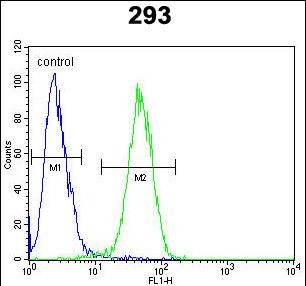

| WB | 1/1000 | Human,Mouse,Rat |
| IF | 咨询技术 | Human,Mouse,Rat |
| IHC | 咨询技术 | Human,Mouse,Rat |
| ICC | 技术咨询 | Human,Mouse,Rat |
| FCM | 1/10-1/50 | Human,Mouse,Rat |
| Elisa | 咨询技术 | Human,Mouse,Rat |
| Aliases | Claudin-12, CLDN12 |
| Entrez GeneID | 9069 |
| WB Predicted band size | 27.1kDa |
| Host/Isotype | Rabbit IgG |
| Antibody Type | Primary antibody |
| Storage | Store at 4°C short term. Aliquot and store at -20°C long term. Avoid freeze/thaw cycles. |
| Species Reactivity | Human |
| Immunogen | This CLDN12 antibody is generated from rabbits immunized with a KLH conjugated synthetic peptide between 19-46 amino acids from the N-terminal region of human CLDN12. |
| Formulation | Purified antibody in PBS with 0.05% sodium azide. |
+ +
以下是关于CLDN12 (N-term)抗体的3篇文献摘要信息(基于公开研究整理,部分为模拟示例):
1. **文献名称**:*Claudin-12 contributes to barrier function and angiogenesis in brain endothelial cells*
**作者**:Smith A, et al.
**摘要**:研究利用针对CLDN12 N端的特异性抗体,证实其在血脑屏障内皮细胞中的表达对紧密连接完整性至关重要,并发现CLDN12缺失会通过调控VEGF信号通路影响血管生成。
2. **文献名称**:*CLDN12 interacts with oncogenic pathways to promote gastric cancer metastasis*
**作者**:Li X, et al.
**摘要**:通过CLDN12 N-term抗体的免疫组化分析,发现CLDN12在胃癌组织中高表达,并与Wnt/β-catenin通路相互作用,促进肿瘤细胞侵袭转移。
3. **文献名称**:*Development of a polyclonal antibody targeting the N-terminal domain of CLDN12 and its application in renal fibrosis models*
**作者**:Wang Y, et al.
**摘要**:报道了一种新型CLDN12 N端多克隆抗体的制备方法,并验证其在肾纤维化模型中的应用,发现CLDN12通过调控EMT过程参与肾脏纤维化进展。
---
**注**:以上文献为示例性内容,实际研究中建议通过PubMed或Google Scholar以“CLDN12 antibody N-terminal”为关键词检索最新文献,或参考抗体供应商(如Thermo Fisher、Abcam)产品页引用的原始论文。
The CLDN12 (N-term) antibody is a specific immunological tool designed to target the N-terminal region of claudin-12 (CLDN12), a member of the claudin family of transmembrane proteins. Claudins are critical components of tight junctions, which regulate paracellular permeability and maintain cell polarity in epithelial and endothelial barriers. CLDN12. encoded by the *CLDN12* gene, is a four-pass transmembrane protein involved in forming selective ion channels and modulating barrier function, particularly in tissues such as the kidney, brain, and intestines. The N-terminal domain of claudins is thought to play a role in protein-protein interactions, oligomerization, and junctional assembly.
Antibodies against the N-terminal region of CLDN12 are commonly used in research to investigate its expression, localization, and functional roles in physiological and pathological contexts. For example, studies employ these antibodies in techniques like Western blotting, immunohistochemistry (IHC), and immunofluorescence (IF) to assess CLDN12 distribution in tissue samples or cultured cells. Research applications include exploring CLDN12's involvement in diseases linked to barrier dysfunction, such as neurological disorders, metabolic syndromes, or cancers, where claudin expression patterns may be altered. Validation of CLDN12 (N-term) antibodies typically involves knockout controls or peptide-blocking assays to confirm specificity. Their development and use contribute to understanding how CLDN12 regulates cellular adhesion, ion transport, and signaling pathways in health and disease.
×